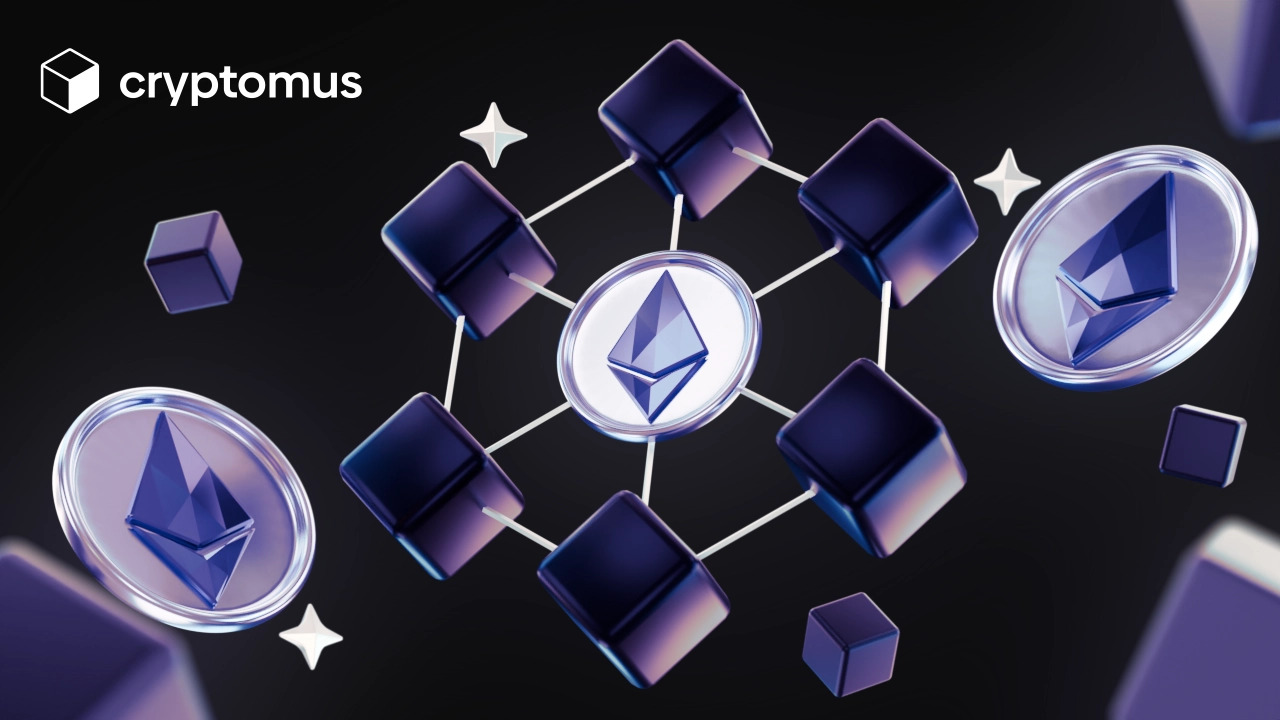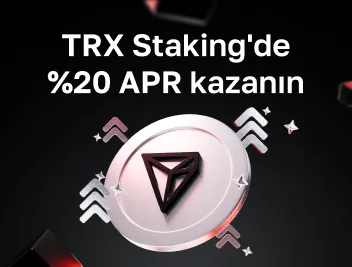
DeFi Staking Nedir?
DeFi staking, DeFi protokolleri ve teknolojilerini kullanarak kripto para biriminizi bir blockchain ağına yerleştirerek pasif gelir elde etmenin bir yoludur. Finansın (DeFi) merkezi olmayan doğası nedeniyle kripto endüstrisinde aktif olarak gelişen bir uygulamadır. DeFi staking, şu anda birçok kripto meraklısının ilgisini çekiyor, bu yüzden süreci ayrıntılı olarak anlamak ve takip etmek önemlidir. Bu makale, DeFi staking'in ne olduğunu ve nasıl çalıştığını öğrenmenize yardımcı olacaktır.
DeFi Nedir?
Merkezi olmayan finans (DeFi), blockchain tabanlı bir finansal ekosistemdir. İçindeki tüm işlemler şifrelenmiş kodla kaydedilir ve halka açık bir defterde saklanır.
Klasik finans sistemiyle karşılaştırıldığında, işlemler bir banka veya diğer kurumlar tarafından yönetilirken, blockchain'de aracı yoktur. İşlemler, aynı blockchain ağı üzerindeki kullanıcılar tarafından matematiksel görevleri çözerek ve zincire yeni bloklar ekleyerek doğrulanır.
Bu merkezi olmayan yaklaşım, kullanıcıların anonimlik sağlamasını ve verilerini güvende tutmasını sağlar. Ayrıca, ödeme doğrulama ve varlık sahipliği kayıtları, kullanıcıları sahtecilik faaliyetlerinden korur. Bu nedenle, DeFi'nin finansal işlemleri daha güvenli ve şeffaf hale getirdiğine inanılmaktadır.
DeFi Staking Nasıl Çalışır?
DeFi staking, bir blockchain ağını çalışır durumda tutmak için kripto para birimini bir akıllı sözleşmeye kilitlemek anlamına gelir. Karşılığında, staker'lar ek paralarla ödüllendirilir.
DeFi staking'in nasıl çalıştığını anlamak için bu sürecin ana unsurlarını bilmelisiniz.
-
Proof-of-Stake (PoS) mekanizması. Bu, belirli bir miktar kriptoyu teminat olarak bloke etmek anlamına gelir, bu da işlemlerin doğrulanmasını ve yeni blokların oluşturulmasını sağlar.
-
Doğrulayıcı düğümler. Bunlar, blockchain'in tam bir kopyasını depolayan ve konsensüse ulaşılmasını sağlayan düğümlerdir. Düğümler, doğrulayıcılar tarafından yönetilir.
-
Staking havuzları. Kullanıcılar, staking için yeterli kripto paraya sahip değillerse, birden fazla ağ katılımcısının fonlarının birleştiği havuzları kullanırlar. Bu, işlemin doğrulama için seçilme şansını artırır. Ödüller konusunda, havuz katılımcıları katkılarına göre ödülleri aralarında dağıtırlar.
-
Akıllı sözleşmeler. Bunlar, staking ve unstaking kurallarını ve koşullarını oluşturan teknolojilerdir. Ayrıca, staking ödüllerinin dağıtım sürecini otomatikleştirirler.
-
Kesintiler ve cezalar. Ağ bütünlüğünü korumak için, PoS mekanizmaları kısıtlamalar içerir. Doğrulayıcılar görevlerini yerine getiremezlerse, bazı varlıkları el konulur. Bu tür bir önlem, kötü niyetli eylemleri önler ve belirli bir ağın güvenliğini garanti eder.
DeFi staking sürecinin bazı risklerle geldiğini hatırlamak önemlidir. Örneğin, Ethereum blockchain'inde staking yaparken, staking sözleşmelerinde hatalarla karşılaşabilirsiniz. Bu hatalar, token'ların birkaç hafta boyunca kilitlenmesine neden olabilir. Bu nedenle, staking yaparken algoritmayı ve kuralları takip etmek önemlidir.
Kripto para birimini stake etmeye nasıl başlayacağınızı açıklayan birkaç adım:
1. Bir DeFi staking platformu seçin. DeFi staking platformu, kullanıcıların dijital varlıklarını kilitleyebilecekleri bir yer, yani bir web sitesi gibi bir yerdir. En popüler seçenekler kripto cüzdan sağlayıcıları ve kripto borsalarıdır. Seçerken, itibar, güvenlik önlemleri ve staking seçeneklerinin çeşitliliğini göz önünde bulundurmalısınız.
2. Bir doğrulayıcı seçin. İşlemlerinizin doğrulayıcısını seçerken, güvenilirliğini ve platformdaki performans geçmişini de göz önünde bulundurmalısınız. Güvenilir bir doğrulayıcı, varlıklarınızın güvende olma olasılığını artırır.
3. Kriptonuzu stake edin. Bu adımda, coin'lerinizi blockchain ağına yatırmanız gerekir. Miktar, potansiyel ödülünüzü belirleyecektir.
4. Ödülleri alın. Staking geliriniz, her dönemin sonunda size kredi olarak verilir. Blockchain ağının koşullarına bağlı olarak, ödül alma günlük, haftalık, aylık veya başka bir şekilde olabilir.
DeFi Staking Türleri
DeFi staking, DeFi protokolleri ve teknolojilerini kullanarak token'ları depolamanızı sağlar. DeFi ekosistemine katkıda bulunurken blockchain katılımcılarına pasif gelir elde etme fırsatları sunar. Örneğin, belirli bir miktar kripto yatırarak bir blockchain doğrulayıcı olma fırsatı vardır, bu da size daha fazla kazanma imkanı verir. Ancak yeterli miktara sahip değilseniz, DeFi staking türlerinden birini seçebilirsiniz. Ayrıntılı olarak inceleyelim:
-
Yönetim staking'i. Bu durumda, kullanıcılar blockchain ağı veya protokolünün yönetimine katılmak için token'ları kilitlerler. Coin'lerini stake ederek, protokol güncellemeleri veya parametre değişiklikleri üzerinde etkili olma konusunda bir söz sahibi olurlar. Bu, paydaşların merkezi olmayan sistemin yönünü belirlemelerine olanak tanır.
-
DAO staking. DAO'lar, akıllı sözleşmeler ve token sahipleri tarafından yönetilen otonom organizasyonlardır. Bu staking türünde, ekosisteme yapılan katkılar, kararları etkilemeye ve ödül payları almaya olanak tanır. Bu nedenle, DAO staking, topluluk katılımı ve finansal kazancı birleştirir.
-
Yield farming. Strateji, birden fazla kripto varlığı farklı platformlara taşıyarak kazançları maksimize eder. Yield farming katılımcıları, varlık sağlayarak, farklı protokolleri kullanarak ve DeFi ekosistemine aktif olarak katkıda bulunarak pasif gelir elde ederler.
-
Likidite havuzları. Bu durumda, token'lar likidite havuzlarına yerleştirilir ve ticaret komisyonları ve diğer teşvikler ödül olarak hareket eder. Bu, aracılara ihtiyaç duymadan merkezi olmayan ticaret sağlar.

En İyi DeFi Staking Platformları
Daha önce de belirttiğimiz gibi, DeFi platformları kullanıcıların kripto para birimlerini stake edebilecekleri özel hizmetlerdir. Bu nedenle, işlemlerinizin güvenli ve karlı bir şekilde yapılabilmesi için böyle bir platformu dikkatlice ve titizlikle seçmeniz gerekir.
Sizin için 5 önde gelen güvenilir DeFi platformunu öğrenmenizi öneriyoruz:
-
Binance. Platform, 100'den fazla kripto para birimini destekler ve hatta komisyon ödemeleri için kendi BNB token'ına sahiptir. Binance, yüksek likiditeye ve staking işlemlerinde yüksek hıza sahiptir. Ancak, ödüllerinizi çekmek isterseniz fiat para birimleri listesi sınırlıdır. Ayrıca, bazı ülkelerde teknik destek mevcut değildir, bu yüzden zorlukları kendiniz halletmeniz gerekecektir.
-
Bybit. Platform, yüksek likiditeye ve varlıklarınızın güvenliğini sağlamak için gelişmiş güvenlik önlemlerine sahiptir. Esnek staking süreleri de burada sağlanır ve ödüller oldukça rekabetçidir. Stake edilen varlıkların çekilmesi bekleme süresi gerektirdiğinden likiditeyi etkileyebilir ve kullanıcılar hızlıca coin'lere erişemeyebilir.
-
KuCoin. Platform, kullanıcı dostu arayüzü ve net gezinme araçlarıyla ünlüdür. Staking'in iyi yanı, ayarlanabilir kilitlemesüreleri ve esnek staking seçeneklerinin olmasıdır. Bu avantajlara rağmen, KuCoin'de staking hizmetlerinin kullanımını engelleyen teknik sorunlar ortaya çıkabilir.
-
OKX. Platform, 100'den fazla farklı coin ve token ile çalışma imkanı sunar. Ayrıca, paydaşlar ve yatırımcılar için genel olarak kullanışlı bir çözüm olan gerçek zamanlı fiyat değişiklik bildirimleri gibi gelişmiş araçlara sahiptir. Ancak, borsa düşük likiditeye sahiptir ve fiat para birimi ile çalışırken erişilemez.
-
Cryptomus. Platformda staking için en popüler ve gerekli kripto para birimleri ve çalışma süreci için çok uygun koşullar vardır. İlk olarak, Cryptomus üzerinde 5 seçenek arasından staking türünü seçebilirsiniz. İkincisi, fikrinizi değiştirirseniz coin'lerinizi herhangi bir zamanda unstake edebilirsiniz. Üçüncüsü, sorunlarınızı mümkün olan en kısa sürede çözebilecek teknik destek vardır. Ayrıca, Cryptomus üzerindeki işlemler şifreleme teknolojisi ile korunur ve ağ katılımcıları kayıt sırasında titizlikle kontrol edilir, böylece burada gönül rahatlığıyla staking yapabilirsiniz.
Kendi DeFi Staking Platformunuzu Nasıl Geliştirirsiniz?
DeFi pazarında, kendi staking platformunuzu geliştirmenin de bir kavramı vardır. Bu, blockchain ağlarındaki staking etkinliğini artırmak için merkezi olmayan uygulamalar (dApps) veya protokoller oluşturma sürecidir. Kendi projelerine sahip olmak, yatırımcılar için ek gelir sağlama konusunda harika bir fırsattır. Kendi staking platformunuzu geliştirmek için belirli adımları takip etmeniz gerekir:
-
Adım 1: Platformun kurallarını ve koşullarını belirleyin. İlk olarak, DeFi staking platformunuzun işlevlerini tanımlamalısınız. Desteklenen kripto para birimlerini seçin, staking seçeneklerini ve ödül dağıtım mekanizmalarını tanımlayın ve güvenlik önlemlerini sağlayın.
-
Adım 2: Akıllı sözleşmeler geliştirin. Akıllı sözleşmeler, platformunuzun süreçlerini otomatikleştirir. Staking mantığını ve ödül dağıtımını yönetmek için gereklidirler.
-
Adım 3: Arayüzü oluşturun. Platformu kullanıcı dostu ve sezgisel olarak anlaşılır hale getirin. Yapısal özelliklere ve tasarıma dikkat edin.
-
Adım 4: Güvenlik denetimi yapın. Akıllı sözleşmeleri ve kod tabanını zayıf noktalar için kontrol edin ve sorunları nasıl hafifletebileceğinizi görün. Bunu yapmak için uzmanları işe almak en iyisidir.
-
Adım 5: Platformunuzu blockchain ağlarıyla entegre edin. Stake yapmayı planladığınız blockchain'leri seçin ve platformunuza entegre edin. Kullanıcıların cüzdanlarını sorunsuz bir şekilde bağlayıp stake yapabilmeleri için her şeyi doğru bir şekilde ayarlayın.
-
Adım 6: Test edin. Platformunuzun kapsamlı testler aracılığıyla doğru çalıştığından emin olun. Stake etme ve çekme gibi farklı senaryoları deneyin, böylece platformun işlevselliğini doğrulayın.
-
Adım 7: Kuralları uygulayın. Platformda uyum gereksinimlerini geliştirin ve yayınlayın. Bunlar, örneğin, doğrulama ve KYC prosedürlerini içerir.
-
Adım 8: Kullanıcıları katılmaya teşvik edin. Bir kitle çekmek ve platformu tanıtmak için bir pazarlama stratejisi oluşturun. Bunu ortaklıklar ve sosyal medya aracılığıyla yapabilirsiniz.
DeFi protokollerindeki toplam değer milyarlarca doları aşıyor. Bu şaşırtıcı değil: Merkezi olmayan finans, kullanıcılara finansal hizmetler elde etmenin daha güvenli yöntemlerini sunar. Bunlardan biri, aktif ticaret yapmadan pasif gelir elde etmenizi sağlayan DeFi staking'dir. Yatırım yapmanın ve para kazanmanın uygun ve güvenli bir yoludur.
Okuduğunuz için teşekkür ederiz! Bu rehberin DeFi staking'in özelliklerini anlamanıza yardımcı olduğunu ve şimdi staking yapmayı ve bu süreçten sadece fayda sağlamayı bildiğinizi umuyoruz.
Makaleyi değerlendirin








yorumlar
0
Yorum yazmak için giriş yapmış olmalısınız